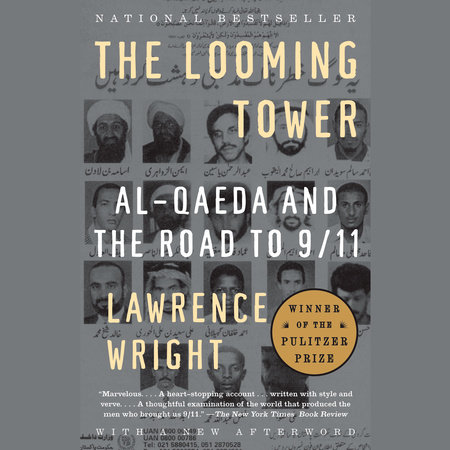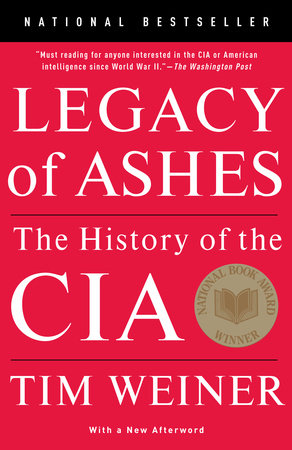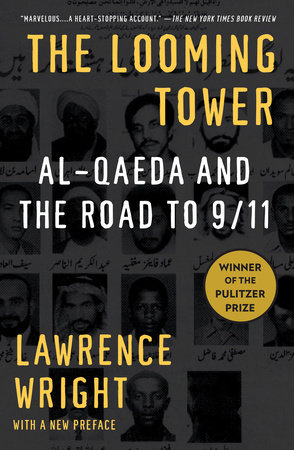

The Looming Tower
By Lawrence Wright
By Lawrence Wright
By Lawrence Wright
By Lawrence Wright
By Lawrence Wright
Read by Lawrence Wright
By Lawrence Wright
Read by Lawrence Wright
Category: Domestic Politics | World History
Category: Domestic Politics | World History
Category: Domestic Politics | World History | Audiobooks

-
$20.00
Aug 21, 2007 | ISBN 9781400030842
-
Aug 08, 2006 | ISBN 9780307266088
-
May 16, 2017 | ISBN 9780525529736
992 Minutes
Buy the Audiobook Download:
YOU MAY ALSO LIKE

The World as It Is

Sticky Fingers

Legacy of Ashes

The Snakehead

Wilson

Alexander Hamilton

Across the Wire

One Day

Our Man
Praise
NATIONAL BOOK AWARD FINALIST
“Marvelous. . . . Not just a heart-stopping account of the events leading up to 9/11, written with style and verve. . . . A thoughtful examination of the world that produced the men who brought us 9/11.” —The New York Times Book Review
“At once wrenchingly intimate and boldly sweeping in its historical perspective. . . . A narrative history that possesses all the immediacy and emotional power of a novel.” —The New York Times
“A stunningly well-researched opus that puts the catastrophe in vibrant context.” —Entertainment Weekly
“Lawrence Wright’s book is my new touchstone. None of the previous books led me to say ‘Aha, now I think I understand’ as frequently.” —Steve Weinberg, The Boston Globe
“Should be required reading for every American; yes, it is that good. It is hard to imagine a better portrait of 9/11 and its causes emerging anytime soon.” —The Christian Science Monitor
“Powerful and important . . . a history of a man and a movement, replete with the accidents of history and historic inevitability.” —Kevin Horrigan, St. Louis Post-Dispatch
“Don’t read The Looming Tower in bed. This book requires a straight spine and full attention . . . The reporting is so good that it will matter in 100 years. Wright’s determined, disciplined work has made his book indispensable. “ —Karen Long, The Plain Dealer
“A page-turner . . . encompassing religion, politics, economics and more. If you’ve been meaning to sharpen your understanding of what all led up to September 11, 2001, then Wright may have written just what you’ve been waiting for.” —Tom Gallagher, San Francisco Chronicle
“Brilliant . . . describes the contorted intellectual journey that has taken place among some Muslims which allows a holy book that appears to condemn suicide and the killing on innocents to be used to justify catastrophic terrorism.” —Stephen Fidler, Financial Times
“A magisterial, beautifully crafted narrative . . . This focus on character, along with Wright’s five years of fierce on-the-ground reporting (he lists 560 interviewees), pays off.” —Daniel Kurtz-Phelan, Los Angeles Times
“Deeply researched . . . immaculately crafted.” —Peter Bergen, The Wall Street Journal
“What a riveting tale Lawrence Wright fashions in this marvelous book. ‘The Looming Tower’ is not just a detailed, heart-stopping account of the events leading up to 9/11, written with style and verve. [It’s] a thoughtful examination of the world that produced the men who brought us 9/11, and of their progeny who bedevil us today. The portrait of John O’Neill, the driven, demon-ridden F.B. I. agent who worked so frantically to stop Osama bin Laden, only to perish in the attack on the World Trade Center, is worth the price of the book alone. ‘The Looming Tower’ is a thriller. And it’s a tragedy, too.” —Dexter Filkins, The New York Times Book Review cover
“Dozens of intricately reported books about 9/11 are already available; I had read perhaps half of them [before] starting The Looming Tower. But Lawrence Wright’s book is my new touchstone. None of the previous books led me to say ‘Aha, now I think I understand’ as frequently.” —Steve Weinberg, The Boston Globe
“A magisterial, beautifully crafted narrative . . . This focus on character, along with Wright’s five years of fierce on-the-ground reporting (he lists 560 interviewees), pays off.” —Daniel Kurtz-Phelan, Los Angeles Times
“Deeply researched . . . immaculately crafted.” —Peter Bergen, The Wall Street Journal
“A searing view of the tragic events of September 11, 2001, a view that is at once wrenchingly intimate and boldly sweeping in its historical perspective . . . a narrative history that possesses all the immediacy and emotional power of a novel, an account that indelibly illustrates how the political and the personal, the public and the private were often inextricably intertwined.” —Michiko Kakutani, The New York Times
“Important, gripping . . . One of the best books yet on the history of terrorism.” —Publishers Weekly, starred review
“Lawrence Wright provides a graceful and remarkably intimate set of portraits of the people who brought us 9/11. It is a tale of extravagant zealotry and incessant bumbling that would be merely absurd if the consequences were not so grisly.” —Gary Sick
“Lawrence Wright’s integrity and diligence as a reporter shine through every page of this riveting narrative.” —Robert A. Caro
“A towering achievement. One of the best and more important books of recent years. Lawrence Wright has dug deep into and written well a story every American should know. A masterful combination of reporting and writing.” —Dan Rather
“Comprehensive and compelling…Wright has written what must be considered a definitive work on the antecedents to 9/11…Essential for an understanding of that dreadful day.” —starred Kirkus review
Awards
J. Anthony Lukas Book Prize WINNER 2007
L.A. Times Book Prize (History) WINNER 2007
Lionel Gelber Prize WINNER 2007
New York Public Library Helen Bernstein Award for Excellence in Journalism WINNER 2007
New York Times Editors’ Choice WINNER 2006
PEN/USA Literary Award WINNER 2007
Pulitzer Prize WINNER 2007
Arthur Ross Book Award NOMINEE 2007
National Book Awards NOMINEE 2006
21 Books You’ve Been Meaning to Read
Just for joining you’ll get personalized recommendations on your dashboard daily and features only for members.
Find Out More Join Now Sign In
















